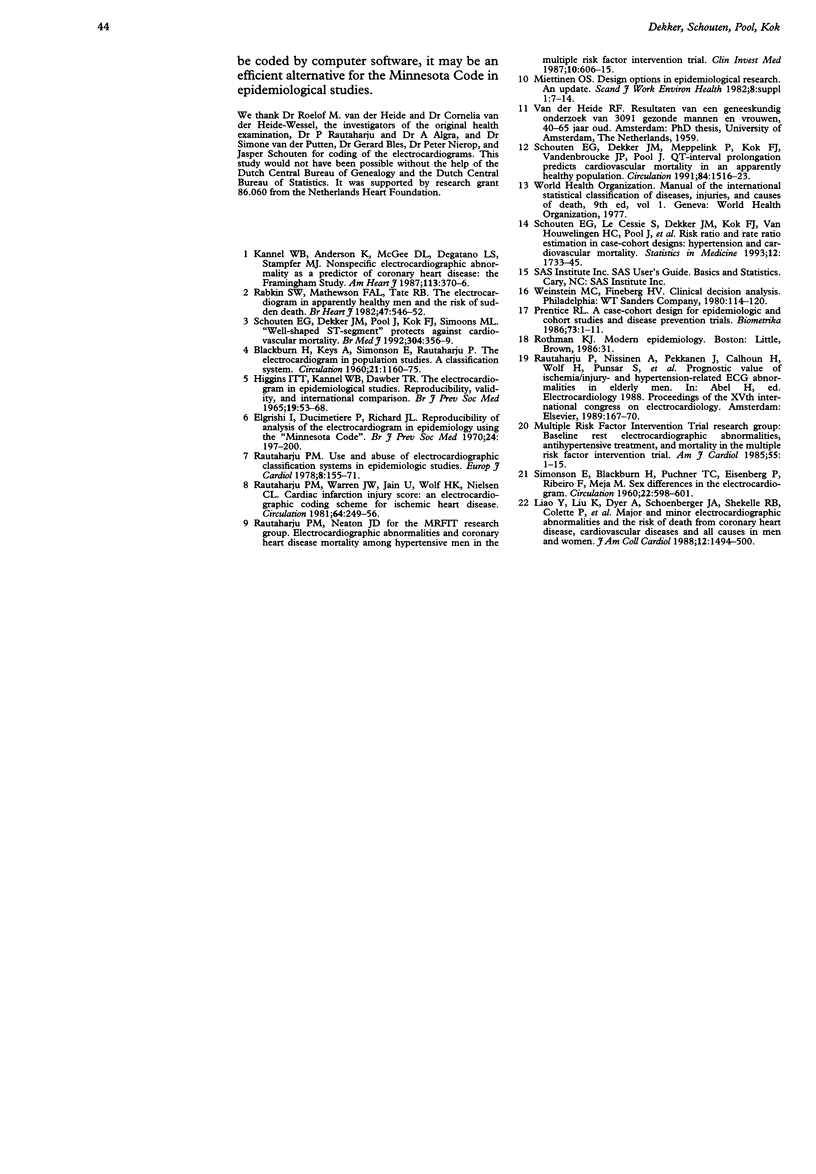Abstract
OBJECTIVE--The Cardiac Infarction Injury Score (CIIS) is an electrocardiogram classification system that was developed to identify ischaemic heart disease. As well as being of diagnostic value, the CIIS may also be of prognostic value. DESIGN--The prognostic value of the CIIS for mortality of coronary heart disease and cardiovascular disease was assessed in a 28 year follow up study of 3091 apparently healthy middle aged men and women (Dutch Civil Servants Study). RESULTS--The rates of coronary heart disease and cardiovascular disease mortality during the first 15 years of follow up were significantly higher in men and women with a CIIS of > 10 than in those with a CIIS of < or = 0 (rate ratio of coronary heart disease mortality 2.9 (95% confidence interval 1.5 to 5.8) for men and 5.6 (2.0 to 15.5) for women). Coronary heart disease mortality was also higher in men with a CIIS of 1-10 than in men with CIIS of < or = 0. When individuals with major Minnesota code items were excluded, the associations were weaker and no longer statistically significant. CONCLUSION--These results indicate that a high CIIS is a risk indicator for coronary heart disease mortality in the general population. Classification of electrocardiograms by means of the CIIS seems to be equivalent to classification by a combination of Minnesota code items. Because CIIS coding is simpler and can be performed by computer it may be more efficient than the Minnesota code for classifying cardiac injury in epidemiological studies.
Full text
PDF





Selected References
These references are in PubMed. This may not be the complete list of references from this article.
- BLACKBURN H., KEYS A., SIMONSON E., RAUTAHARJU P., PUNSAR S. The electrocardiogram in population studies. A classification system. Circulation. 1960 Jun;21:1160–1175. doi: 10.1161/01.cir.21.6.1160. [DOI] [PubMed] [Google Scholar]
- Elgrishi I., Ducimetiere P., Richard J. L. Reproducibility of analysis of the electrocardiogram in epidemiology using the 'Minnesota code'. Br J Prev Soc Med. 1970 Nov;24(4):197–200. doi: 10.1136/jech.24.4.197. [DOI] [PMC free article] [PubMed] [Google Scholar]
- HIGGINS I. T., KANNEL W. B., DAWBER T. R. THE ELECTROCARDIOGRAM IN EPIDEMIOLOGICAL STUDIES: REPRODUCIBILITY, VALIDITY, AND INTERNATIONAL COMPARISON. Br J Prev Soc Med. 1965 Apr;19:53–68. doi: 10.1136/jech.19.2.53. [DOI] [PMC free article] [PubMed] [Google Scholar]
- Kannel W. B., Anderson K., McGee D. L., Degatano L. S., Stampfer M. J. Nonspecific electrocardiographic abnormality as a predictor of coronary heart disease: the Framingham Study. Am Heart J. 1987 Feb;113(2 Pt 1):370–376. doi: 10.1016/0002-8703(87)90280-8. [DOI] [PubMed] [Google Scholar]
- Liao Y. L., Liu K. A., Dyer A., Schoenberger J. A., Shekelle R. B., Colette P., Stamler J. Major and minor electrocardiographic abnormalities and risk of death from coronary heart disease, cardiovascular diseases and all causes in men and women. J Am Coll Cardiol. 1988 Dec;12(6):1494–1500. doi: 10.1016/s0735-1097(88)80016-0. [DOI] [PubMed] [Google Scholar]
- Miettinen O. Design options in epidemiologic research. An update. Scand J Work Environ Health. 1982;8 (Suppl 1):7–14. [PubMed] [Google Scholar]
- Rabkin S. W., Mathewson F. L., Tate R. B. The electrocardiogram in apparently healthy men and the risk of sudden death. Br Heart J. 1982 Jun;47(6):546–552. doi: 10.1136/hrt.47.6.546. [DOI] [PMC free article] [PubMed] [Google Scholar]
- Rautaharju P. M., Neaton J. D. Electrocardiographic abnormalities and coronary heart disease mortality among hypertensive men in the Multiple Risk Factor Intervention Trial. Clin Invest Med. 1987 Nov;10(6):606–615. [PubMed] [Google Scholar]
- Rautaharju P. M. Use and abuse of electrocardiographic classification systems in epidemiologic studies. Eur J Cardiol. 1978 Sep;8(2):155–171. [PubMed] [Google Scholar]
- Rautaharju P. M., Warren J. W., Jain U., Wolf H. K., Nielsen C. L. Cardiac infarction injury score: an electrocardiographic coding scheme for ischemic heart disease. Circulation. 1981 Aug;64(2):249–256. doi: 10.1161/01.cir.64.2.249. [DOI] [PubMed] [Google Scholar]
- Schouten E. G., Dekker J. M., Kok F. J., Le Cessie S., Van Houwelingen H. C., Pool J., Vanderbroucke J. P. Risk ratio and rate ratio estimation in case-cohort designs: hypertension and cardiovascular mortality. Stat Med. 1993 Sep 30;12(18):1733–1745. doi: 10.1002/sim.4780121808. [DOI] [PubMed] [Google Scholar]
- Schouten E. G., Dekker J. M., Meppelink P., Kok F. J., Vandenbroucke J. P., Pool J. QT interval prolongation predicts cardiovascular mortality in an apparently healthy population. Circulation. 1991 Oct;84(4):1516–1523. doi: 10.1161/01.cir.84.4.1516. [DOI] [PubMed] [Google Scholar]
- Schouten E. G., Dekker J. M., Pool J., Kok F. J., Simoons M. L. Well shaped ST segment and risk of cardiovascular mortality. BMJ. 1992 Feb 8;304(6823):356–359. doi: 10.1136/bmj.304.6823.356. [DOI] [PMC free article] [PubMed] [Google Scholar]


